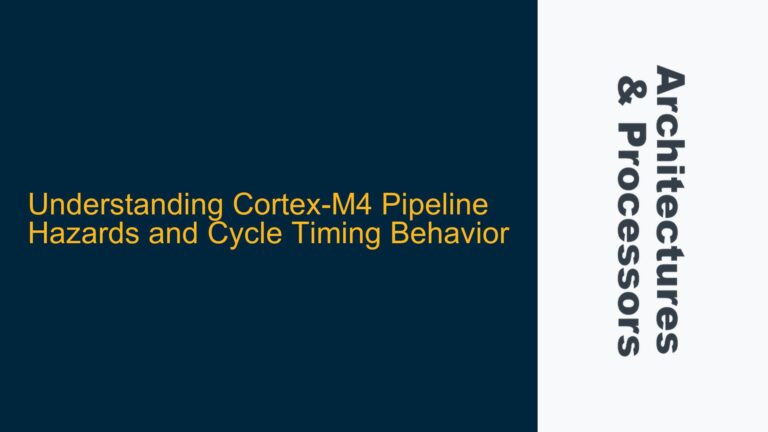ARM Cortex-M3 For Loop Cycle Count Calculation
The cycle count of a for loop in an ARM Cortex-M3 microcontroller, such as the LPC1768, is a critical consideration for developers working on real-time systems, timing-sensitive applications, or performance optimization. The cycle count depends on several factors, including the compiler’s optimization level, the specific instructions generated, and the underlying hardware architecture. In this analysis, we will break down the cycle count for a simple for loop, such as for(i=0; i<1; i++);, and explore the factors influencing its execution time.
The Cortex-M3 processor is a 32-bit RISC processor with a 3-stage pipeline (fetch, decode, execute), which means that instruction execution is generally deterministic. However, certain factors, such as memory access latency, branch prediction, and compiler optimizations, can introduce variability. To calculate the cycle count of the loop, we must first examine the disassembled code generated by the compiler.
For example, when compiling the loop with no optimization, the generated assembly code might look like this:
movs r3, #0 ; Initialize i = 0
str r3, [r7, #4] ; Store i in memory
.loop:
ldr r3, [r7, #4] ; Load i from memory
cmp r3, #0 ; Compare i with 0
bgt .loopexit ; Branch if i > 0
ldr r3, [r7, #4] ; Load i from memory
adds r3, r3, #1 ; Increment i
str r3, [r7, #4] ; Store i back to memory
b .loop ; Branch back to .loop
.loopexit:
Each instruction in the Cortex-M3 has a defined cycle count, as specified in the Technical Reference Manual (TRM). For instance:
MOVS,CMP, andADDStypically take 1 cycle.LDRandSTRtake 2 cycles due to memory access.- Branches (
BGT,B) take 1 cycle if not taken, and 3 cycles if taken (due to pipeline reload).
Using these cycle counts, we can calculate the total cycles for the loop. For a single iteration of the loop, the cycle count would be:
MOVS: 1 cycleSTR: 2 cyclesLDR: 2 cyclesCMP: 1 cycleBGT: 1 cycle (not taken)LDR: 2 cyclesADDS: 1 cycleSTR: 2 cyclesB: 3 cycles (taken)
Adding these up, the total cycle count for one iteration of the loop is approximately 15 cycles. However, this calculation assumes ideal conditions, such as no memory access delays or pipeline stalls. In practice, factors like flash memory acceleration, cache behavior, and alignment can affect the actual cycle count.
Compiler Optimization Impact on Loop Cycle Count
Compiler optimizations play a significant role in determining the cycle count of a for loop. Modern compilers, such as GCC or Clang, are designed to eliminate redundant or unnecessary code, which can drastically alter the generated assembly and, consequently, the cycle count.
When compiling the loop with optimization enabled, the compiler may recognize that the loop has no observable effect (i.e., it does not modify any external state) and remove it entirely. For example, the optimized assembly might reduce the loop to a single instruction or even eliminate it completely. This behavior is particularly common at higher optimization levels (e.g., -O2 or -O3).
To ensure that the loop is not optimized away, developers can introduce a side effect, such as modifying a volatile variable or toggling a GPIO pin. For instance:
volatile int i;
for(i=0; i<1; i++);
In this case, the volatile keyword ensures that the compiler treats i as a variable that can be modified outside the current code scope, preventing the loop from being optimized out. The generated assembly will then include the loop, allowing for accurate cycle count analysis.
However, even with a side effect, the compiler may still apply optimizations that reduce the loop’s cycle count. For example, it might unroll the loop or replace it with a more efficient sequence of instructions. Therefore, developers must carefully examine the disassembled code to understand the exact behavior of the optimized loop.
Flash Acceleration and Memory Access Considerations
The Cortex-M3 processor in the LPC1768 microcontroller includes a flash accelerator, which can introduce non-deterministic behavior in instruction fetch timing. The flash accelerator is designed to improve performance by prefetching instructions and buffering them for faster access. However, this can lead to variability in cycle counts, especially for tight loops that rely on precise timing.
To achieve deterministic execution, developers can disable the flash accelerator or use tightly coupled memory (TCM) for critical code sections. TCM is a high-speed memory region that provides predictable access times, making it ideal for real-time applications. By placing the loop code in TCM, developers can eliminate the variability introduced by the flash accelerator and ensure consistent cycle counts.
Additionally, memory alignment and access patterns can impact cycle counts. For example, unaligned memory accesses or crossing cache line boundaries can introduce additional latency. Developers should ensure that variables used in the loop are properly aligned and that memory access patterns are optimized for the target architecture.
Practical Steps for Cycle Count Analysis and Optimization
To accurately determine the cycle count of a for loop and optimize its performance, developers should follow these steps:
-
Examine the Generated Assembly Code: Use tools like Godbolt’s Compiler Explorer or the disassembly view in your IDE to inspect the assembly code generated by the compiler. This will provide insight into the exact instructions being executed and their cycle counts.
-
Account for Compiler Optimizations: Be aware of how different optimization levels affect the generated code. Use the
volatilekeyword or other techniques to prevent the compiler from optimizing away the loop. -
Consider Hardware-Specific Factors: Take into account the impact of flash acceleration, memory alignment, and cache behavior on cycle counts. Use TCM or disable flash acceleration if deterministic timing is required.
-
Use Simulation and Profiling Tools: Run the code in a simulator or use profiling tools to measure the actual cycle count. This can help identify any discrepancies between the theoretical and actual cycle counts.
-
Optimize the Loop Structure: If the loop is performance-critical, consider rewriting it to reduce the number of instructions or memory accesses. For example, unrolling the loop or using register variables can improve efficiency.
By following these steps, developers can gain a deeper understanding of the factors influencing the cycle count of a for loop in an ARM Cortex-M3 microcontroller and implement optimizations to achieve the desired performance.
Conclusion
The cycle count of a for loop in an ARM Cortex-M3 microcontroller is influenced by a combination of compiler optimizations, instruction set architecture, and hardware-specific factors. By carefully analyzing the generated assembly code, accounting for compiler behavior, and considering hardware considerations, developers can accurately determine the cycle count and optimize their code for performance. Whether working on real-time systems or performance-critical applications, a thorough understanding of these factors is essential for achieving reliable and efficient embedded systems.






